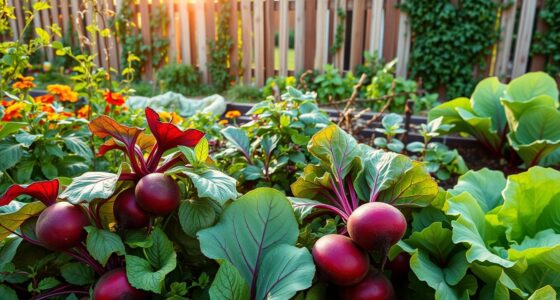Imagine stepping into your vineyard, surrounded by lush green vines heavy with promising grapes. You take a deep breath, inhaling the rich, earthy scent of the soil mixed with the sweet fragrance of ripe fruit. It’s a moment that embodies your passion and dedication to this thriving piece of land. But what if there’s a way to enhance this experience even further? By integrating grape companion plants into your vineyard, you can nurture a more vibrant ecosystem, promote healthier grapevines, and ultimately boost your yield. This guide will delve into the best grape vineyard companions, revealing how these plants can work harmoniously with your grapes, transforming your vineyard into a haven of productivity and life.
Key Takeaways
- Grape companion plants can enhance soil health.
- They provide natural pest control methods.
- Companion planting improves pollination.
- Creating a biodiversity-rich environment benefits your vineyard.
- Selecting the right companions can boost your grape yield.
What Are Grape Companion Plants and Why Should You Care?
Grapevine companion planting is a method that brings together different plants in a way that benefits everyone involved. When choosing companion plants for grapevines, you aim for mutual advantages, such as enhanced growth, pest deterrence, and improved soil health. This approach not only promotes healthier grapevines but also supports sustainable practices within your vineyard.
Definition of Companion Planting
Companion planting involves strategically growing different species of plants in proximity. This method can enhance plant growth, deter pests, and boost biodiversity. For your grapevines, incorporating the right companion plants is crucial. Employing this practice can create a more resilient environment that supports the growth of the best plants to grow with grapes.
Benefits of Companion Planting for Grapes
Utilizing companion plants for grapevines yields numerous benefits. Here are a few of the notable advantages:
- Pest Management: Certain plants can repel harmful insects.
- Nutrient Enhancement: Some companions help improve soil quality by fixing nitrogen.
- Biodiversity Promotion: A diverse planting scheme attracts beneficial insects, which help pollinate and control pests.
- Improved Growth: Companion plants can shade and protect young grapevines, promoting healthier growth.
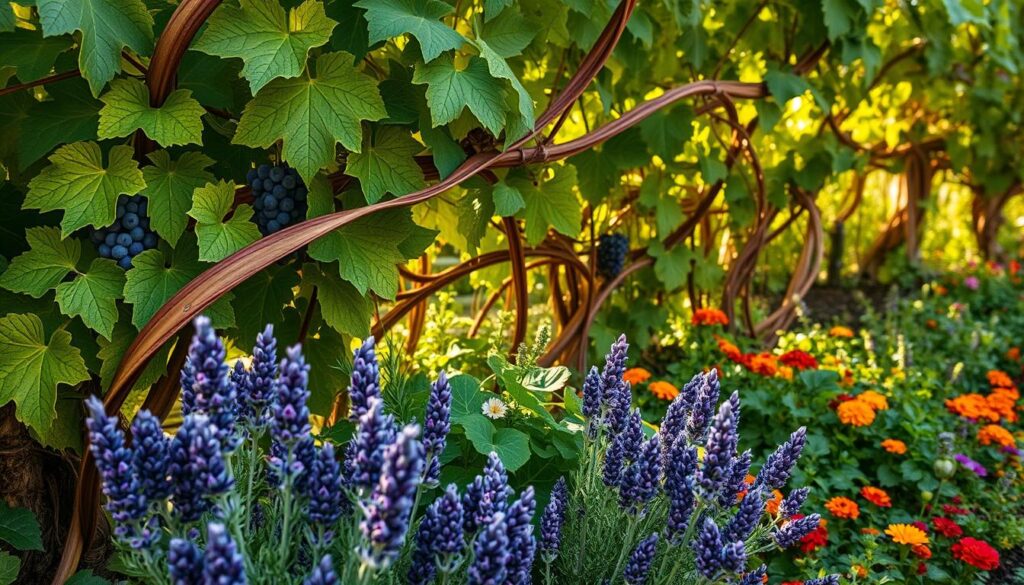
Ideal Growing Conditions for Grapes
Understanding the ideal growing conditions for grapes is essential for creating a thriving vineyard. Factors such as soil type and climate significantly influence the health of your plants. Ensuring the correct environment not only enhances grape vine intercropping but also supports grape vineyard biodiversity, making for a more productive and sustainable growing experience.
Soil Requirements
Grapes flourish in well-draining soil with a pH range of 5.5 to 7.0. This pH level provides the necessary nutrients for optimal growth. Amending your soil with organic matter can improve drainage and nutrient retention. When considering grape vine garden partners, select companion plants that thrive in similar soil types to maintain overall soil health and promote biodiversity.
Sunlight and Climate Considerations
Grapes require ample sunlight for photosynthesis and fruit development. Ideally, they should receive at least six to eight hours of direct sunlight each day. In addition, grapes thrive in moderate climates without extreme temperature fluctuations. For effective grape vine intercropping, ensure that companion plants chosen can tolerate similar climate conditions, aiding in the establishment of a balanced ecosystem within your vineyard.

Top Companion Plants for Grapes
Choosing the right grape vineyard companions can significantly enhance both the health of your grapevines and the quality of your harvest. The best plants to grow with grapes not only serve to protect them from pests but can also improve soil quality and contribute to overall vineyard health. Here are three top recommendations for companion plants for grapevines.
Marigolds: Natural Pest Deterrents
Marigolds are fantastic companion plants for grapevines. Their strong scent deters both aphids and nematodes, protecting your vines from harmful pests. By incorporating marigolds into your vineyard, you can create a naturally balanced ecosystem that minimizes the need for chemical pesticides.
Garlic: Enhancing Flavor and Health
Garlic brings both flavor and health benefits to your vineyard. It acts as a natural pesticide, repelling various pests that threaten your grapevines. This makes garlic one of the best plants to grow with grapes, as it enhances the flavor profile while providing essential protection against harmful insects.
Clover: Nitrogen Fixation Benefits
Clover is another excellent option for grape vineyard companions. As a nitrogen fixer, it enriches the soil, promoting healthier vine growth. Additionally, clover can prevent weed competition, which allows your grapevines to thrive without interference from unwanted plants.
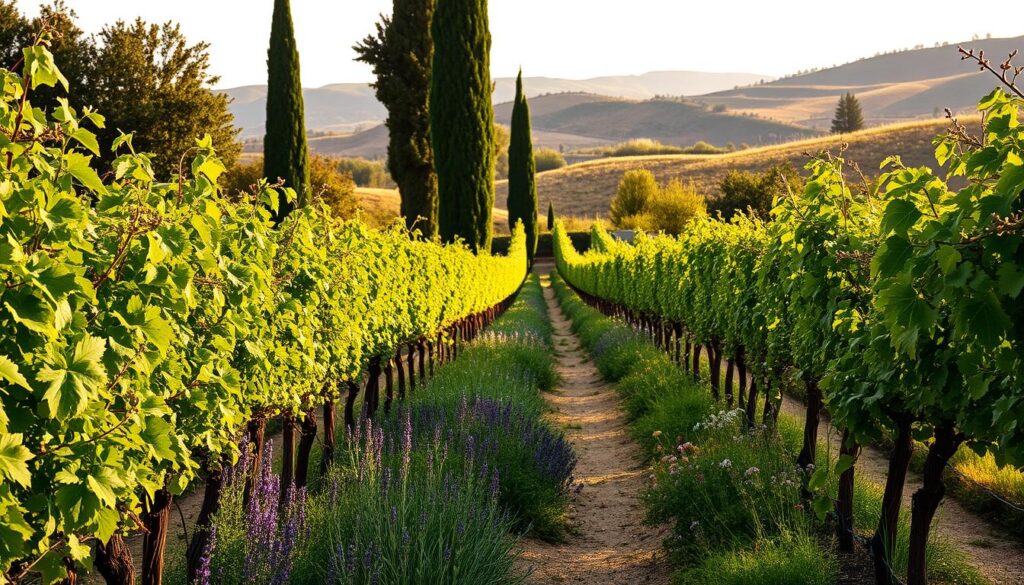
Enhancing Biodiversity in Your Vineyard
Biodiversity plays a crucial role in the health and sustainability of your vineyard. By fostering a diverse ecosystem, you create a more resilient environment capable of withstanding various challenges. Implementing strategies such as grape vine intercropping helps to maximize vineyard biodiversity, ultimately benefiting both the plants and the soil.
Importance of Biodiversity
A diverse ecosystem is fundamental for maintaining balance within your vineyard. Increased grape vineyard biodiversity leads to improved pest control, healthier soil, and a more resilient system overall. This diversity reduces the risk associated with monoculture practices, making your vineyard less susceptible to diseases and environmental stressors. By inviting various crop species into your growing area, you create a thriving habitat for beneficial insects, which support the pollination process and natural pest management.
How Companion Plants Support Ecosystems
Companion plants serve as vital components in promoting vineyard biodiversity. These species attract beneficial insects, including pollinators and natural predators. This not only enhances pest control but also boosts the overall productivity of your grapevines. By integrating companion plants into your vineyard, you create a harmonious ecosystem that encourages diverse biological activity. The interactions between different plants foster nutrient cycling and soil health, essential for sustainable grape production.
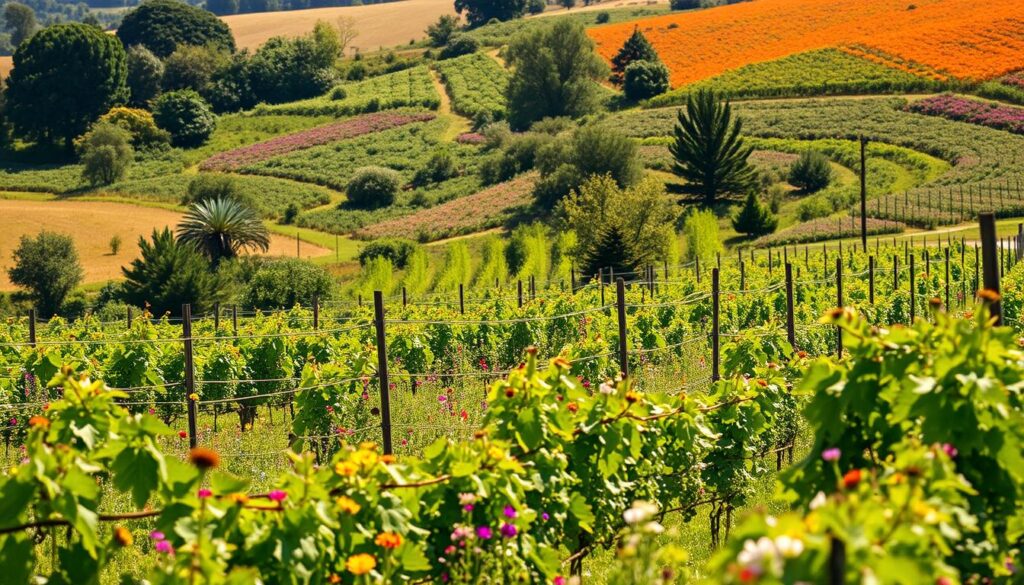
| Aspect | Importance | Benefits of Companion Plants |
|---|---|---|
| Soil Health | Improves nutrient availability and structure | Increases microbial activity, enriching soil |
| Pest Management | Natural predators help control pest populations | Reduced chemical pesticide use |
| Pollination | Enhances fruit set and quality | Attracts pollinators and beneficial insects |
| Disease Resistance | Diverse plants limit disease spread | Strengthens overall vineyard resilience |
How Companion Plants Improve Soil Health
Implementing grapevine companion planting can significantly enhance the overall soil health in your vineyard. By selecting the best plants to grow with grapes, you cultivate a thriving ecosystem that benefits not only your grapevines but the soil they grow in. Understanding how companion plants for grapevines improve soil conditions and nutrient availability is key to successful vineyard management.
Nutrient Exchange Among Plants
Companion planting encourages various plants to interact through their root systems, allowing for nutrient exchange. Plants like clover and vetch play a vital role by fixing nitrogen in the soil, a nutrient essential for grapevine growth. As these legumes establish their roots, they enhance the availability of nitrogen to neighboring plants, promoting healthy vine development with less reliance on chemical fertilizers.
Reducing Soil Erosion and Compaction
The deep rooting systems of certain companion plants help in aerating the soil, which reduces compaction. This aeration allows better water infiltration and root penetration for your grapevines. Cover crops or companion plants with extensive root systems can stabilize the soil structure, minimizing erosion caused by wind and water. As a result, your vineyard benefits from improved soil health and robust grape production.
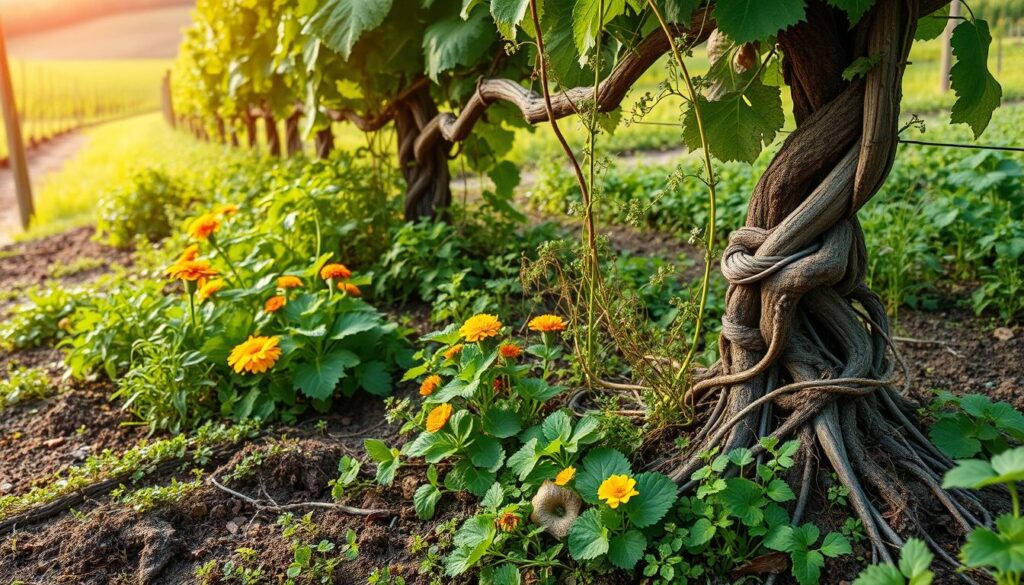
How to Select the Right Companion Plants
Choosing the right companion plants for your grapes involves careful consideration of growth habits and the specific needs of your grapevines. Understanding the characteristics of various plants in your grape vine garden partners can significantly enhance the health and yield of your vineyard.
Matching Companion Plants to Growth Habits
When selecting grape vineyard companions, it is essential to match growth habits with your grapevines. For example, low-growing plants such as clover can provide ground cover and prevent weeds, while taller plants like sunflowers can offer shade and support. You can explore a range of options to establish harmonious relationships among your chosen plants, promoting biodiversity and enhancing the overall ecosystem in your vineyard.
Seasonal Considerations for Planting
Timing is crucial when planning your grapevine companion planting. Certain plants thrive in specific seasons, and their planting schedules can influence the availability of nutrients and water. Planting cool-season crops early in spring can provide nutrients just as the grapes begin to grow. Understanding these seasonal dynamics will help optimize the benefits for your grape vineyard companions, ensuring robust growth and resilience against pests.
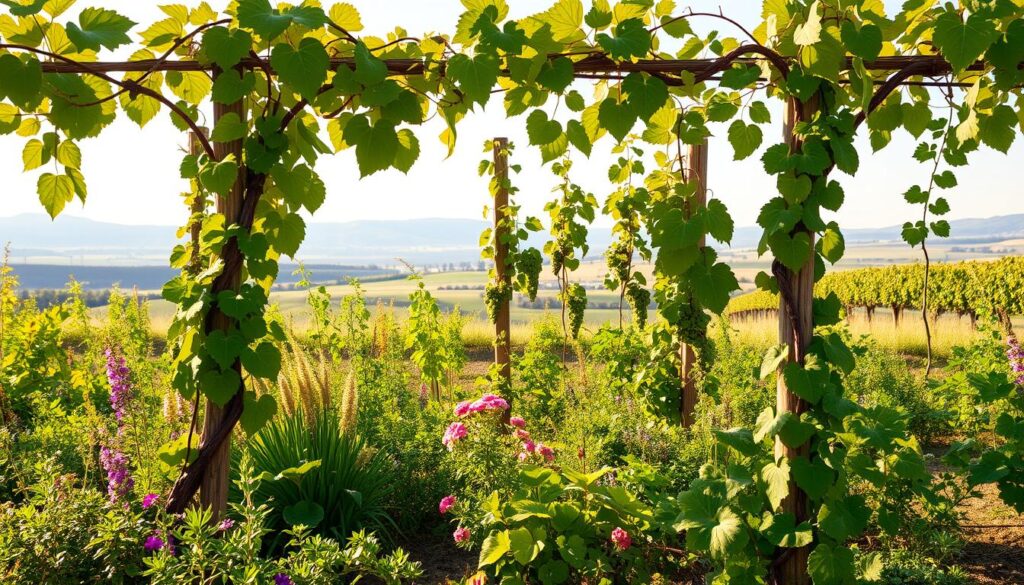
Implementing Companion Planting in Your Vineyard
Strategically implementing grapevine companion planting can elevate your vineyard’s health and productivity. Carefully planning your planting layout and timing can create an environment where grape vineyard companions thrive, enhancing their benefits such as pest deterrence and nutrient availability.
Planning Your Planting Layout
When arranging companion plants for grapevines, consider the growth habits of each plant. Some companions may grow tall, while others remain low to the ground. This diversity helps optimize light exposure, ensuring all plants effectively contribute to the vineyard’s ecosystem. A few key factors include:
- Spacing: Give enough space between grapevines and companions to avoid overcrowding.
- Height: Taller plants can provide shade for sensitive varieties, while low-growing companions can help with ground cover.
- Root Depth: Mixing deep and shallow-rooted plants can enhance soil aeration and moisture retention.
Timing Your Planting for Maximum Benefit
The timing of planting is crucial for achieving the full benefits of companion plants for grapevines. Early planting allows companion plants to establish their root systems, which in turn supports moisture retention throughout the growing season. Consider the following points:
- Spring Planting: Plant companions early in the spring to support young grapevines in their initial growth phases.
- Seasonal Adaptation: Be aware of your specific climate conditions to time plantings effectively, as certain companions may perform better in warm or cooler conditions.
- Monitor Growth: Observe how companion plants affect your grapevines and adjust future planting based on their performance.
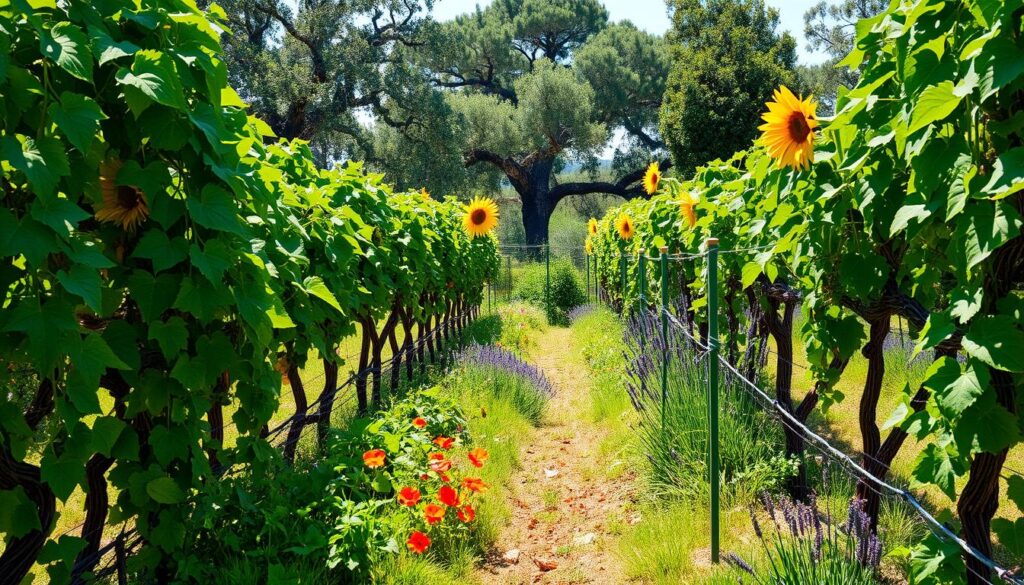
| Companion Plant | Benefit to Grapevines | Best Planting Time |
|---|---|---|
| Marigolds | Pest deterrent | Early Spring |
| Garlic | Flavor enhancement | Early Spring |
| Clover | Nitrogen fixation | Early Spring or Fall |
Common Mistakes in Companion Planting
Engaging in grapevine companion planting presents great opportunities to enhance your grape vineyard biodiversity, yet it can lead to pitfalls if not approached carefully. Awareness of common mistakes allows you to curate the best plants to grow with grapes that encourage mutual benefits rather than competition. Two primary issues can hinder your efforts: overcrowding and selecting incompatible plants.
Overcrowding and Competition
When companion plants are positioned too closely, they vie for nutrients, water, and sunlight. This overcrowding disrupts the access that grapevines require to flourish. Stunted growth often results from this competition, leading to weakened plants and reduced yields. Striking the right balance is essential; ensure that while fostering biodiversity, adequate space allows all plants to thrive.
Selecting Incompatible Plants
Another significant mistake stems from choosing plants that are not well-suited for companionship with grapes. Selecting incompatible plants can lead to resource competition, negatively impacting grapevine health. Research the characteristics and requirements of potential companions to ensure they harmonize with your existing grape plants. Focusing on suitable pairings promotes a thriving grape vineyard ecosystem.
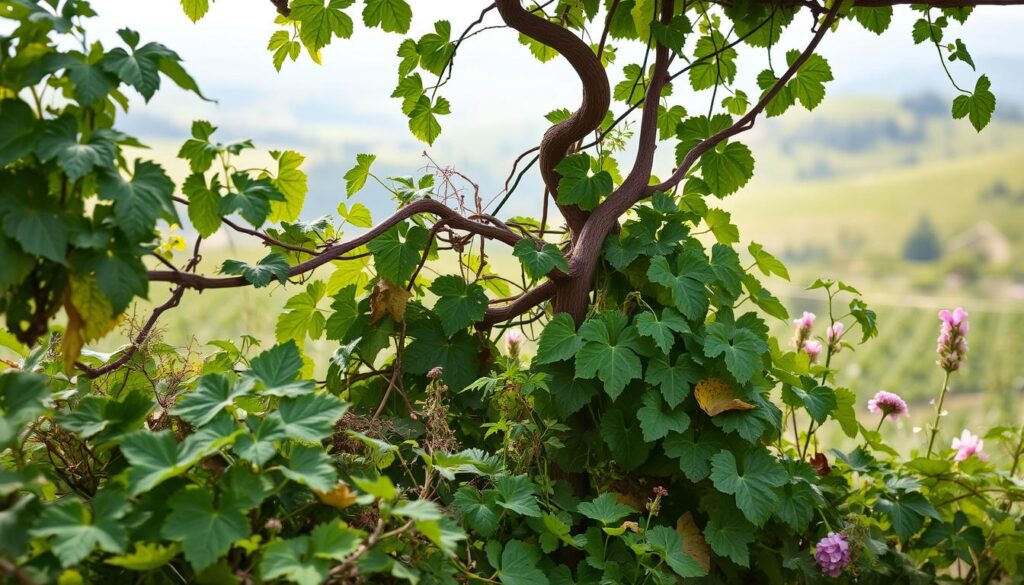
Companion Plants for Disease Resistance
Incorporating effective companion plants for grapevines can significantly bolster disease resistance in your vineyard. With careful selection, you can create a more resilient ecosystem, enhancing both grape health and vineyard biodiversity. Two standout selections in this arena are borage and basil.
Borage: Strengthening Grapes Against Disease
Borage is an excellent choice for enhancing disease resistance among your vine companions. This herb not only helps in protecting grapes from various ailments but also attracts beneficial pollinators. By integrating borage into your vineyard, you contribute to greater grape vineyard biodiversity. Its ability to enrich the soil with trace minerals benefits the entire ecosystem, acting as a natural support to your grapevines.
Basil: Natural Antifungal Properties
Basil offers a myriad of advantages for your grape vines, particularly due to its natural antifungal properties. This delightful herb can combat common diseases such as mildew that can harm your grapes. By planting basil alongside grapevines, you create a symbiotic relationship that promotes overall health. This not only protects your crop but can also elevate the flavor profile of your grapes, making your vineyard even more successful.

Attracting Beneficial Insects with Companion Plants
Creating a thriving vineyard goes beyond the vines themselves. You can enhance your grapevine companion planting efforts by selecting plants that attract beneficial insects. These insects play a crucial role in maintaining a healthy ecosystem, helping to manage pests and improve pollination. Let’s explore some effective strategies to incorporate these plants into your vineyard.
Ladybugs and Lacewings: Nature’s Pest Control
Ladybugs and lacewings are two types of beneficial insects that can significantly aid in pest control within your vineyard. They actively feed on aphids, mites, and other harmful pests, minimizing potential damage to your grapevines. You can attract these natural predators by planting flowers like yarrow and dill among your grape vineyard companions. These flowering plants provide essential nectar sources, increasing the likelihood of ladybugs and lacewings visiting your vineyard.
Pollinator-Friendly Options for Your Vineyard
To ensure a successful grape harvest, you should consider the importance of attracting pollinators. Integrating pollinator-friendly plants such as lavender, bee balm, and sunflowers into your grapevine companion planting strategy can boost pollination rates. These plants offer nectar and pollen that benefit not only pollinators but, ultimately, your grapevines as well. The presence of these beneficial insects helps create a balanced and productive vineyard ecosystem.

Seasonal Companion Planting Strategies
Understanding the timing for planting can significantly enhance the success of grapevine companion planting. By selecting the best plants to grow with grapes based on the seasons, you can create a thriving ecosystem in your vineyard. Effective seasonal companion plants offer distinct benefits, making each growing period unique and advantageous.
Spring Planting Ideas
In spring, focus on fast-growing annuals that can quickly establish beneficial relationships with grapes. Consider incorporating plants like clover, which enhances nitrogen levels in the soil, fostering healthier grape growth. Marigolds serve as natural pest deterrents, protecting your vines during this crucial development phase.
Fall Companion Planting
As the season shifts to fall, it’s time to think about ground covers that will prepare your vineyard for winter. Buckwheat makes an excellent choice, providing a protective layer over the soil while improving nutrient content for the upcoming spring planting. Utilizing these seasonal companion plants not only benefits the current crop but lays the groundwork for a fruitful harvest in the future.

Case Studies: Successful Companion Planting Examples
Exploring real-world examples of grapevine companion planting provides insights into its effectiveness. Two case studies illustrate how applying such strategies enhances grape vineyard biodiversity and overall productivity. These examples showcase the tangible benefits derived from thoughtfully selecting companion plants.
Vineyard A: Enhancing Yield with Herbs
This vineyard achieved remarkable results by incorporating herbs like thyme alongside their grapevines. The presence of these herbs not only enriched the soil but also attracted beneficial insects, creating a healthier ecosystem. As a result, the vineyard experienced higher grape yields, demonstrating the impact of companion planting on productivity.
Vineyard B: Pest Management Success
This vineyard implemented a pest management strategy by planting marigolds among their grapevines. Marigolds effectively deterred harmful pests, reducing the need for chemical interventions. This approach not only preserved the quality of the grapes but enhanced overall vineyard health by promoting grapevine companion planting that supported biodiversity. The success of these initiatives emphasizes the importance of using the best plants to grow with grapes in sustainable vineyard practices.

Sustainable Practices in Vineyard Management
Incorporating sustainable practices into vineyard management can significantly enhance grape quality while minimizing environmental impact. Embracing techniques such as grapevine companion planting offers a path to reduce reliance on harmful chemicals. By leveraging grape vineyard companions, you can foster naturally harmonious ecosystems that not only protect your plants but also promote biodiversity.
Reducing Chemical Inputs Through Companioning
Utilizing grapevine companion planting helps create a naturally resilient environment. Companion plants can deter pests and improve plant health, which often leads to a reduced need for chemical pesticides. As you explore different combinations of grape vineyard companions, consider those that can provide shading or attract beneficial insects. Implementing these practices can lead to healthier grapes while minimizing chemical inputs, aligning with sustainable vineyard management principles.
Crop Rotation and Its Benefits
Another effective strategy is crop rotation. This method not only promotes soil health but also aids nutrient cycling. By alternating the types of crops grown in specific areas of your vineyard, you mitigate soil depletion and improve overall fertility. Crop rotation, when combined with grapevine companion planting, builds a sustainable ecosystem that supports robust grape production. Diversifying your planting approach ensures your vineyard remains fertile and productive in the long run.

Conclusion: Grow a Thriving Vineyard with Companion Plants
Implementing grape companion plants in your vineyard is a powerful way to enhance not only the health of your grapevines but also the entire ecosystem surrounding them. By utilizing strategies such as grapevine companion planting, you can see significant improvements in soil health, effective pest management, and increased grape vineyard biodiversity. These benefits collectively foster a sustainable environment where your vines can thrive.
Recap of Benefits
Throughout this journey into companion planting, it has become clear that the right companion plants can enrich soil nutrients, deter pests, and support beneficial insect populations. This approach leads to a more vibrant and diverse ecosystem, ultimately benefiting the quality and yield of your grapes. Remember, enhancing biodiversity is not just beneficial for your plants; it’s crucial for maintaining a healthy vineyard environment.
Encouragement to Get Started
Now is the perfect time to take action. Start experimenting with various grape companion plants to see which combinations work best in your vineyard. Whether you’re a seasoned viticulturist or a passionate hobbyist, integrating these practices will elevate your vineyard’s sustainability and productivity. Get inspired, and embrace the potential of your land with companion planting today!





